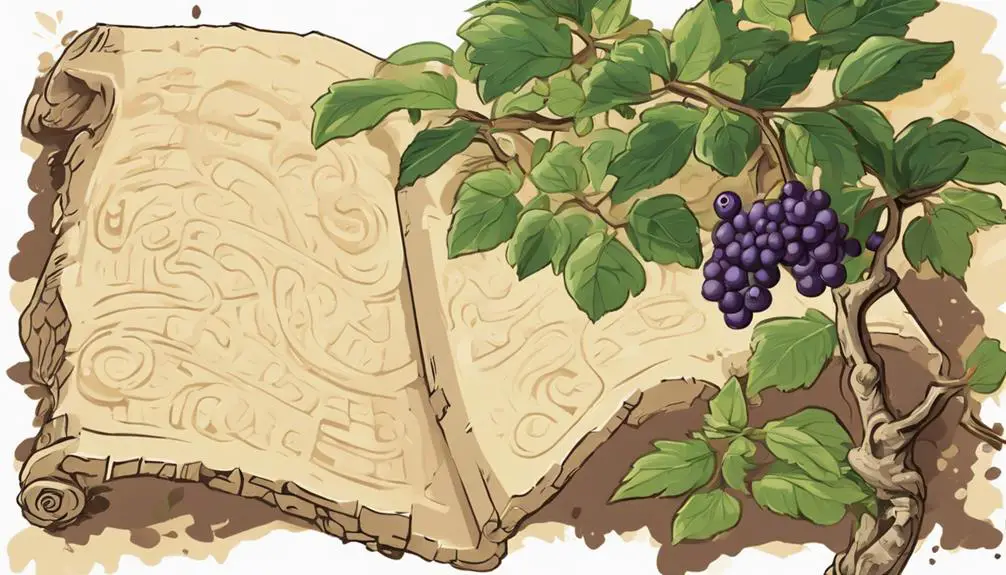Uncover the symbolic meaning of the caperberry in the Bible, a fascinating emblem of life's desires and their transformation over time.

Caperberry in the Bible
When you explore the rich tapestry of the Bible, you'll find the caperberry mentioned in Ecclesiastes 12:5, symbolizing the waning of desire in old age. This intriguing reference not only highlights the plant's historical and cultural significance but also opens a window into the symbolic language of biblical texts.
As you consider its roles and interpretations through time, you might wonder how this ancient symbol can still speak to modern readers. Let's explore how the caperberry's mention weaves into broader themes of life, desire, and the passage of time, offering insights that remain surprisingly relevant today.
Key Takeaways
- Caperberries in Ecclesiastes symbolize life's transience and the futility of worldly pursuits.
- They illustrate the deep connection between nature, spirituality, and human conditions in biblical contexts.
- Historical and modern interpretations reflect on caperberries as metaphors for perseverance amidst life's challenges.
- Their mention encourages exploration of traditional agricultural practices and the preservation of cultural heritage.
Historical Context of Caperberries

Delving into the historical context of caperberries reveals their significance not only as a culinary ingredient but also as a symbol with profound implications in biblical times. These small, piquant fruits were more than just a flavor enhancer; they were a testament to the ingenuity and necessity of ancient agricultural practices. The cultivation of caperberries demanded specific knowledge and skill, reflecting an intimate understanding of the land and its capabilities. This wasn't mere farming; it was a sophisticated interaction with the natural world, showcasing a deep respect for the delicate balance required to coax life from the arid soils of the Mediterranean.
Moreover, the culinary uses of caperberries extended beyond simple seasoning. They were integral to preserving food, a crucial aspect of survival in an era without modern refrigeration. This preservation technique not only underscored the practicality of caperberries but also highlighted their value in ancient society. They were a staple, a necessity, and a luxury all at once, illustrating the complex relationship between food, culture, and survival in biblical times. Through this lens, caperberries emerge not merely as a biblical reference but as a pivotal element of daily life, deeply woven into the fabric of ancient culinary traditions and agricultural practices.
Symbolism in Biblical Texts
Building on the practical significance of caperberries in ancient agricultural practices and culinary traditions, their presence in biblical texts often carries rich symbolic meanings that merit closer examination. You'll find that ancient metaphors and cultural references embedded within these sacred narratives provide a deeper insight into the values and beliefs of ancient societies. Specifically, caperberries, with their unique ability to flourish in harsh conditions, often symbolize perseverance and resilience in the face of adversity. Furthermore, their bitter flavor can represent life's inherent struggles, reminding readers of the complexities and challenges that define human existence.
Analyzing these texts, you'll notice how caperberries aren't merely botanical elements but are imbued with layers of meaning that resonate with the experiences and aspirations of the ancients. They stand as testament to the intricate relationship between nature and spirituality, illustrating how even the smallest elements of the natural world were perceived as reflections of divine principles or human conditions. Through this lens, caperberries transcend their immediate utility, becoming symbols of broader existential themes that continue to inspire contemplation and interpretation.
Mention in Ecclesiastes

Within the context of Ecclesiastes, the caperberry's mention serves as a poignant emblem of life's fleeting pleasures and inevitable decay. This reference, tucked within the tapestry of biblical agriculture, highlights the transient nature of human desires and the ultimate futility found in earthly pursuits. Ecclesiastes analysis often focuses on the book's contemplative and somewhat existential themes, and the caperberry symbol enriches this narrative by offering a tangible metaphor for ephemerality and dissatisfaction.
In delving into this specific mention, several key aspects come to the fore:
- Ecclesiastes' exploration of vanity: The book's overarching theme of the vanity of worldly efforts is underscored by the caperberry's inability to stave off the inevitability of aging and death.
- Biblical agriculture as metaphor: The use of a common agricultural product highlights the everyday, universal nature of the text's philosophical musings.
- The caperberry's cultural significance: In ancient times, the caperberry was believed to stimulate appetite and desire, making its inefficacy in Ecclesiastes a powerful statement on the limits of earthly pleasures.
- A call to introspection: The mention invites readers to reflect on their own pursuits and the ultimate value of their endeavors in the face of life's transience.
Through the caperberry, Ecclesiastes communicates a profound message on the human condition, seamlessly integrating biblical agriculture with deep theological inquiry.
Interpretations Through Time
Throughout history, scholars and theologians have offered diverse interpretations of the caperberry's symbolism in Ecclesiastes, reflecting evolving understandings of its underlying message about life's transience. Translation debates have significantly shaped this evolution. The original Hebrew texts, with their inherent linguistic complexities, have been subject to various translations over the centuries. Each translation, influenced by the cultural perceptions and linguistic norms of its time, has led to nuanced shifts in the interpretation of the caperberry's role.
Initially, interpretations might've centered on the caperberry's literal uses in ancient cultures, such as its properties as a stimulant or its culinary uses, suggesting a metaphor for life's fleeting pleasures or the pursuit of vitality in old age. However, as scholarship advanced, deeper symbolic meanings emerged. The caperberry came to be seen as a representation of human endeavors to stave off the inevitable decline of life and vitality, echoing Ecclesiastes' contemplations on the vanity of such efforts.
These shifts in understanding underscore how cultural perceptions and translation nuances intertwine, influencing the interpretation of biblical texts. As you delve deeper into the caperberry's symbolism, you're witnessing not just a reflection on life's ephemeral nature, but also a fascinating journey through the evolving landscape of biblical interpretation.
Modern Relevance and Lessons

In today's rapidly evolving society, the caperberry's symbolic significance in Ecclesiastes offers profound insights into our ongoing quest for meaning amidst life's transient nature. This ancient metaphor, once rooted in the quest for pleasure and the inevitable disillusionment that follows, has much to teach us about modern pursuits and values. The relevance of the caperberry extends beyond its biblical context, touching on areas such as culinary use and agricultural significance, which are increasingly pertinent in discussions about sustainability and cultural heritage.
- Culinary Use: The caperberry, celebrated for its unique flavor, invites us to explore diverse cuisines, fostering a deeper appreciation for cultural traditions and the joy found in culinary exploration.
- Agricultural Significance: Its cultivation reflects a commitment to sustainable agriculture, emphasizing the importance of preserving traditional farming methods in a rapidly modernizing world.
- Cultural Heritage: The caperberry serves as a bridge between past and present, reminding us to value and preserve our cultural heritage amidst globalization.
- Sustainability: Its use and cultivation encourage a dialogue on sustainable living practices, highlighting the caperberry as a symbol of balance and harmony with nature.
Frequently Asked Questions
How Are Caperberries Cultivated, and What Are the Agricultural Challenges Associated With Their Growth?
To cultivate caperberries, you've got to nail the soil requirements first; they thrive in well-drained, rocky soil and need a good amount of sunlight.
The agricultural challenges are mainly about harvest timing. You have to pick them at just the right moment before they flower for the best quality.
Missing this window can drastically affect their taste and market value, making the cultivation process quite precise and sometimes stressful for farmers.
Can Caperberries Be Used in Contemporary Cooking, and Do They Hold Any Nutritional Benefits?
Yes, you can use caperberries in contemporary cooking, and they offer nutritional benefits. These versatile berries can be a unique addition to dishes, such as in caperberry cocktails, enhancing flavors with their distinct taste.
Their medicinal uses, rooted in their antioxidant properties, contribute to their value in a balanced diet. By incorporating caperberries into your meals, you're not just adding a burst of flavor but also tapping into their health-promoting qualities.
Are There Any Specific Religious Rituals or Traditions in Judaism or Christianity Today That Still Utilize Caperberries?
You're barking up the wrong tree if you're looking for caperberries in today's religious rituals. Despite their Biblical symbolism, modern adaptations of Judaism and Christianity rarely feature them.
Scholars analyze these shifts, noting that while caperberries once held significant religious meaning, contemporary practices have evolved. This evolution reflects a broader trend of interpreting sacred texts in a way that resonates with current values and understandings, sidelining caperberries in the process.
How Do the Culinary Uses of Caperberries Differ Across Various Cultures Around the World?
Culinary uses of caperberries vary globally, reflecting diverse cultural preferences in preservation and flavor comparison. You'll find them pickled in Mediterranean dishes, offering a tangy burst, while in Middle Eastern cuisine, they're often dried, enhancing their piquant taste.
In European countries, caperberry preservation techniques can differ widely, from brining to vinegar-based pickles, each method altering the flavor profile. This versatility showcases how cultures adapt and infuse unique tastes into traditional and contemporary dishes.
What Are the Environmental Impacts of Caperberry Cultivation, and How Does It Affect Local Ecosystems?
Interestingly, as you dive into the environmental impacts of caperberry cultivation, you'll find it's a tale of climate adaptation and its effects on local ecosystems.
These resilient plants, adept at thriving in harsh conditions, can alter local wildlife dynamics, attracting specific species while potentially displacing others.
Analyzing this, you realize the nuanced balance between agricultural practices and ecosystem health, highlighting the importance of mindful cultivation to mitigate negative wildlife impacts.
Conclusion
In the tapestry of biblical narratives, caperberries emerge not just as flora but as potent symbols of fleeting pleasure and the inevitability of death. Like a desert flower that blooms briefly before succumbing to the sun's wrath, they remind us to discern life's transient joys amidst its ephemeral nature.
Through Ecclesiastes, their mention becomes a beacon for scholars, guiding interpretations that bridge ancient wisdom with modern existential quests. Thus, caperberries endure, offering lessons as relevant today as they were millennia ago.



Sign up